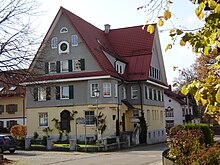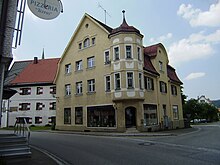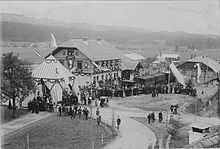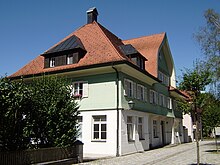Building in Weiler-Simmerberg
In the townscape of Weiler-Simmerberg , there are some buildings that are often related to the history of the suburbs Weiler, Simmerberg or Ellhofen. The local market architect Georg Bufler made a name for himself with a large number of representative buildings .
building
Sennhof
The Sennhof is in Weiler im Allgäu at Fridolin-Holzer-Straße 40 (map: ⊙ ). It was built in 1929/1930 by the local market builder Georg Bufler and from that time until 1970 it was the school building of the teaching and research institute for Emmental dairy with living rooms for the prospective herdsmen on the upper floor. The training and research facility, founded in 1890 as one of three important measures taken by the dairy pioneer Josef Widmann , was relocated to Sonthofen from 1902 to 1910 and was later called the Dr. Anton Fehr School .
The forerunner building - the first dairy school, so to speak - was the so-called "Haus Embacher" located in Fridolin-Holzer-Straße 22, which today houses the Weiler local editorial office of the newspaper "Der Westallgäuer" (map: ⊙ ). Pp. 314, 686.
Widmann House
In 1911 a laboratory and office building for the teaching and research institute was built not far from the Sennhof; at today's house Fridolin-Holzer-Str. 29 reminds a plaque as well as the name of the Widmannplatz in front of the great sponsor of the dairy industry.
Former court
The former courthouse in Weiler im Allgäu is at Alois-von-Brinz-Straße 10 (map: ⊙ ). At the end of the 18th century, Franz Josef Rädler ran a spinning and weaving mill (factory combined with home work) in Weiler. In 1802 he built this building as a factory for muslin and calico production . With the connection of the Westallgäu to Bavaria in 1806, the basis of business (sales area Austria and duty-free transport) was destroyed. Rädler was one of the three leading hamlets opponents of the annexation of the former Austrian territories to Bavaria, had participated in the Vorarlberg people's uprising as major in a state rifle company in 1809 and had to stay abroad because of the threat of persecution. Returning trusting an amnesty, he was arrested anyway and was not released until 1813. Pp. 268, 274.
The Bavarian state confiscated its unfinished factory and established the “Royal Bavarian Regional Court” Weiler there for the period from 1807 to 1866. Since administration (executive) and judiciary were not yet separated at the lowest level until 1861, the regional court and at its head the regional judge represented the extended arm of state power, with approximately a united regionally limited power of a mayor and district administrator. After the administrative reform, it became a "Royal Bavarian District Court" and after the First World War a "Bavarian District Court" (1918–1970).
In 1971 Helmut coal, the son of the painter August coal, bought the building, renovated it inside and outside and converted the upper floors for residential purposes. He decorated the tasteful exterior facade on the ground floor with paintings depicting scenes from the history of the building, its residents and the place. On the ground floor he set up his paint shop and showrooms for the pottery of his wife Emilie, geb. Bentele a. Since 1991 the residential and commercial building has housed an architecture office and a model shop. P. 644
The unadorned building behind the former court was Weiler's second prison until the end of the Second World War (the first prison is called "Altes Loch" and is located on the property opposite on the other side of Alois-von-Brinz-Straße) . An industrial, hotel, restaurant and private laundry has been using the building on the ground floor and an extension since 1959. After several renovations, there are now apartments instead of the former prison cells on the first floor. P. 642
Department store home
The building erected by master builder Georg Bufler in 1902 at Fridolin-Holzer-Strasse 13 (plan: ⊙ ) is known today for the Prof. Karl Hummel botanical collection set up there . In 1882, Friedrich Heim took over his parents' agricultural property opposite and had this stately department store built 20 years later. For three decades, the merchant also made a name for himself as First Mayor of Weiler and was the driving force behind the construction of the Röthenbach-Weiler local railway .
In 1937 his nephew, the businessman and Traube landlord Fritz Heim, took over the house for 20 years, and from 1957 to 1968 the tenant couple Konrad. From 1968 onwards, Karl and son Norbert Hummel ran their Hummelsche pharmacy here until they moved to the new Sparkasse building on the corner of Bahnhofstrasse and Hauptstrasse. In the meantime, until the plant science collection of Prof. Hummel was taken up, it served as a reform shop. Pp. 669, 670.
Eschenlohr House
In 1910, the master builder Georg Bufler built this multifaceted, elegant, large commercial building at Alois-von-Brinz-Strasse 1 on the corner of Fridolin-Holzer-Strasse (plan: ⊙ ). It later housed the Netzer shoe store, the Vogler milk bar, the Faller exhibition shop, the Pult sports shop and a nail salon, among other things. P. 53 The building with its stucco ceilings and many Art Nouveau elements was partially renovated in 2013. The market planned to create another museum facility in it and to present the Wiedra Collection with its 800 to 1000 exhibits to the public. In a referendum on June 21, 2015, however, the majority of voters spoke out against the market community buying the Eschenlohr House.
Former train station
In the time of the dawn of industry and trade in the second half of the 19th century, the increasingly dense railway network played an important role. Weiler also tried to use the improved transport option by rail for local production and in the 1870s submitted several - albeit unsuccessful - applications to the Bavarian state government to build a branch line from Weiler to Röthenbach on the Bavarian Allgäubahn .
Finally, (market and private shareholders) resorted to self-help and raised a total of 330,000 Reichsmarks. With the financing secured in this way, Munich approved the construction of a Vizinalbahn in 1891 and had the construction work carried out by the Royal Bavarian State Railways . The former Weiler im Allgäu train station was built at the northern end of the former town and operations on the municipality's own local railway line Weiler-Röthenbach opened on July 22, 1893.
The community sold the railway line to the Deutsche Reichsbahn in 1920 because of the worsening economic development . The Federal Railroad finally stopped passenger transport in 1960 and freight transport in 1991. P. 438
Bahnhofsviertel
After the Weiler train station went into operation, the station district around Bahnhofsstrasse and Bahnhofsplatz developed into an upscale residential and business location during the period of economic upswing before the First World War. The market builder and entrepreneur Georg Bufler (1878–1950) planned and built several residential, commercial and factory buildings here in 1906 with an Art Nouveau-oriented façade, the uniformity of which gives the station square its own character.
Milz and Karg straw hat factory
The two Lindenbergers Fidel Milz (straw hat manufacturer) and Ferdinand Karg (businessman) founded the Milz & Karg factory in 1907. The architect and master builder Georg Bufler built the impressive four-storey building consisting of two T-shaped wings at the upper end of the station square, today Jakob-Lang-Straße 2 (plan: ⊙ ) in Weiler im Allgäu. With Art Nouveau-oriented elements in the plastered facades as well as curved roof gables in the neo-baroque style and classicistic column imitations at the corners, he succeeded in integrating the massive factory building into the surroundings of the other smaller residential and commercial buildings on the station square.
In 1922 the Kempten bank clerk Andreas Haupt and the hamlet Benedikt Zinth († 1955) bought the company. Brother Ignaz Zinth († 1965) took over the Haupt'schen share in 1928 and the brothers converted the hat factory to knitwear production. The company received awards in the 1930s for its modern machine park and the quality of its products.
After Ignaz Zinth's death, the knitwear factory Milz & Karg KG and its equipment were transferred to Fritz Binder-Rist KG from Herbertingen, who wanted to use the hamlet as an additional mainstay for their production. In order to adapt to the changed market conditions, the hat, scarf and glove production was discontinued and a few years later the wage-intensive production of chunky sweaters on hand machines. With high-quality knitted fashion and natural fiber products, the Pfister family managed to continue the company even in a difficult environment. Pp. 622-623
The building capacity, which was no longer required in the original scope, is used, among other things, by a doctor's practice, an architectural office and an investment advisor.
Villa Inama
Master builder Georg Bufler built the villa in 1903–1904 on Bahnhofsplatz (today Bahnhofstrasse 14 (plan: ⊙ )) for the whip manufacturer Nicolò Inama from Trentino. Later, several café-restaurants with boarding houses were set up one after the other in the neat building: Café Bader, Café Weichselbaumer, Café Weiler, Villa Gallen, Villa Lessing.
Nicolò Inama came from a family of whip makers from the Non Valley in Trentino , whose ancestors can be traced back to the 14th century. The Inamas also sold their products abroad to Austria (Vorarlberg), Switzerland, Germany, France and America through a cooperative. Descendants of Giovanni Inama (1774–1832) followed these sales relationships in these countries and founded Inama lines that are still in existence today (also in Weiler im Allgäu). In 2010, the wife of the eldest male hamlet descendant, Herbert Inama, gave away the last stick of whip she owned to a collector.
Nicolò Inama made whipsticks from Italian twine wood and ran a wine shop with, among other things, self- pressed Trentino / South Tyrolean white and red wines. In 1918 he sold the house to the Wagner couple. Anton Walch ran a cooperage in the workshop . In 1920 the restaurateur Weichselbaumer acquired the building and used it as a café. In 1936 ownership changed to the Bader couple, who maintained the café tradition. The wife and daughter of the father of the family, who was missing in the Russian campaign in 1945, renovated in 1972 and rebuilt the front and the counter in 1981. Confectioner Zeimetz took over the property in 1981, but died in 1988. The Gallen family continued operations as a café-restaurant with a pension. In 1991, a multi-stage renovation of the guest house began, in the course of which the roof was completely renewed in 1993 and efforts were made to keep the plans of the builder Bufler. Pp. 643-644
Stadelmann office building
The house on Bahnhofsplatz at Bahnhofstrasse 10, built in 1910 by architect and builder Georg Bufler for Benedikt Stadelmann (plan: ⊙ ), remained in the family's possession until 1964. From 1912 to 1927 Anton Hörmann ran a manufactory, haberdashery, white and woolen goods store there, and Fridolin Haas ran a delicatessen store from 1927 to 1929. In 1929 it became a grocery store of the Augsburg Bernhard Müller chain with tenant Josef Betzler for many years until 1964. His son Werner Betzler took over in 1951, bought the building in 1964 from Osmana Stadelmann, the granddaughter of the original builder, and continued to run it as the Betzler delicatessen at the train station . P. 639 Today the men’s beverage store is on the ground floor of the building.
Baldauf commercial building
Architect and master builder Georg Bufler built this office building in 1910 on Bahnhofsplatz at Bahnhofstrasse 9 (plan: ⊙ ) for the Baldauf family. The married daughter Habrunner opened an Kaiser's coffee shop and later G. Weichselbaumer a delicatessen with groceries and colonial goods. From 1919 to 1924 the Bayerische Handelsbank, Depositenkasse Weiler im Allgäu operated a branch here, which was then replaced by the savings and loan association Weiler im Allgäu until the 1950s. After founding the Raiffeisenbank Westallgäu and moving to the newly acquired commercial building on Hausbach, three photo shops followed (Photo-Atelier Wenig, Photo-Shop Hill and Photo-Shop with Atelier Wiest). P. 681–682 Today the building houses the sales rooms of the Post-Pharmacy, which was moved here diagonally across from the Sinds office building.
Villa Stromeyer
The villa was built by the architect and builder Georg Bufler on Bahnhofsplatz at Kristinusstraße 11 (plan: ⊙ ) as the director's residence for Stromeyer and Cie. built. The spa doctor Ennemoser later bought the property and set up his doctor's practice on the ground floor. Today it is rented and is run by the couple, the doctor couple Pfeiffer.
Post office building
The neat and representative post office building at Bahnhofstrasse 7 not far from the old train station ( ⊙ ) was completed in 1912 by master builder Georg Bufler and is now used as a residential building. P. 52
Dental studio heart
Master builder Georg Bufler built this house behind the Villa Inama at Bahnhofstrasse 6 for the bath and dentist Josef Herz and his services in so-called minor surgery such as tooth extraction, cupping and bloodletting . In 1919 Johann Sinds bought it and opened a drugstore with colonial and colored goods, which two daughters continued to run until 1969. In addition, another daughter owned a women's hat shop with wool and fashion goods. The Helmbrecht women's hairdressing salon had also been in the building since 1919, which then moved to the Stadelmann office building in 1934. The Sinds drugstore was rebuilt in 1966 and relocated to a modern extension. From 1969 to 1991 son Siegbert Sinz ran the drugstore there; his wife Rosemarie took over the textile business in 1975. From 1993 to 2008, Armin Kling ran his post-office pharmacy in the premises of the former drugstore, which he then moved diagonally across to the former Stadelmann office building. Pp. 673-674
Notary's villa
This representative building at Alois-von-Brinz-Straße 17 is still in the vicinity of the former train station and has the typical external features of the Bufler buildings that were built before the First World War.
literature
- Gerd Zimmer: Georg Bufler - An important West Allgäu master builder , in the yearbook of the Lindau district 1992, Wilfried Eppe publishing house, Bergatreutre, pages 49–58, ISBN 3-89089-025-3 .
- Georg Wagner, Gerd Zimmer: Heimatbuch Weiler im Allgäu. Verlag Buchdruckerei Holzer, Weiler im Allgäu 1994. Publisher: Markt Weiler-Simmerberg (on the occasion of the 1100 anniversary of the first documentary mention).
Web links
Individual evidence (comments, notes)
- ↑ a b c d e f g h i j k l see literature Georg Wagner, Gerd Zimmer: Heimatbuch Weiler im Allgäu.
- ↑ a b see literature Gerd Zimmer: Georg Bufler - A significant Westallgäuer builder
- ↑ see Weiler-Simmerberg could buy the Eschenlohr house; Space for a new museum ( page no longer available , search in web archives ) Info: The link was automatically marked as defective. Please check the link according to the instructions and then remove this notice. das allgäu online from February 17th, 2012, Weiler
- ↑ see the allgäu online from June 22, 2015, Weiler
- ↑ see web link Genealogy of the Inama Le Famiglie de Inama di Dermulo














